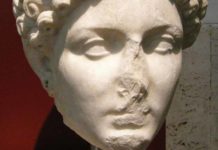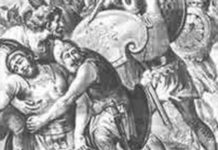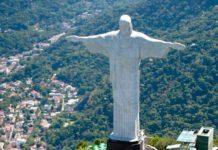The Forum Romanum was the main and central forum of the city of Rome. It became the economic, political, and religious center of the city in early Republican times, around the seventh century B.C. It continued to be an important functional and symbolic area of Rome through the city – and the Empire’s – evolution, and changed along with the times.
One highly important function of the Forum Romanum was as a center of administration and politics. Several buildings in this area were dedicated to this purpose, allowing the Senate and other high-ranking Romans to have a place to meet and make decisions, but to also allow other Romans to gather and hear announcements and proclamations.
Regia
Located at the southeast end of the Forum Romanum, this was originally the residence of the first kings of Rome (from the Latin rex, “king”). According to tradition, this building was constructed by Numa Pompilius, the second king of Rome (715 – 674 B.C.) During the Republic, it held sacred artifacts, and subsequently became the office of the Pontifex Maximus, Rome’s high priest. This title was held by Julius Caesar, and eventually by Augustus in 12 B.C. The title was then kept solely for the Emperor, and in the Imperial era of Rome, the Regia was merely a symbol of Rome’s history.
Comitium
The Comitium is where all official governmental and political activity went on in Rome. It was a main area of the Forum Romanum, and no doubt quite busy. This area was actually a complex of other administrative buildings, including the Curia (the Senate house) and the Rostra. It dates back to about 600 B.C., as an open space that was rectangular in shape. This space, known as a templum (a precursor to the temple, it was an open meeting space, but no less sacred), was where both high-ranking Roman citizens and the Roman gods could come together (in theory) to hear announcements and make important decisions on the city’s behalf.
In the Republican era (around 250 B.C.), the Comitium evolved into an amphitheatre-like setting (no doubt influenced by the Greeks), and it was round with steps that lowered to a central point for a speaker. Right before Julius Caesar’s death in 44 B.C., he began reorganizing the Forum, and decided to move all political function away from this area to the main square of the Forum, as the population had grown too large to be accommodated in the Comitium. Augustus completed Caesar’s restorations after his assassination.
Curia Hostilia
As part of the Comitium, the Curia served as the meeting place for the Roman Senate during the Republic. The original Curia (from the Latin for “council”) dates back to about 550 B.C., and was thought to have been built by Tullius Hostilius, Rome’s third king.
Between 80 – 50 B.C., the Senate met in the larger Curia Cornelia, built by Sulla. It burned to the ground in 52 B.C., and in the Imperial era, the Senate met in the Curia Julia.
Rostra
Located in the main square of the Forum Romanum, the Rostra was the speaker’s podium, from which all official announcements and proclamations were made to the Roman people by magistrates and consuls. Julius Caesar moved this important monument to the Forum in 44 B.C. from the Comitium. The Rostra (from the Latin for “ship’s prow” or “bird’s beak”) came from the ships that were destroyed by Rome at the Battle of Antium in 338 B.C. This was used as a commemorative monument that symbolized Rome’s power and its long-term dominance over its foes, as well as having a very functional purpose.
Tabularium (Latin for “archives” or “registry”)
Located in the western area of the Forum Romanum, this was the official record-keeping office of Rome. Very careful records were kept of all official commercial, political, and military occurrences and events.
Rome was big on spectacle, and understood the importance of size. These buildings were all very functional, but held huge significance to the people of Rome, and were intended to inspire awe and admiration in Rome’s visitors.








